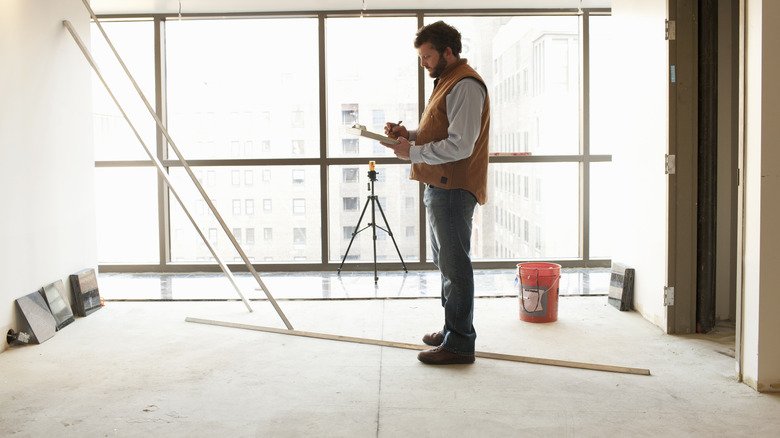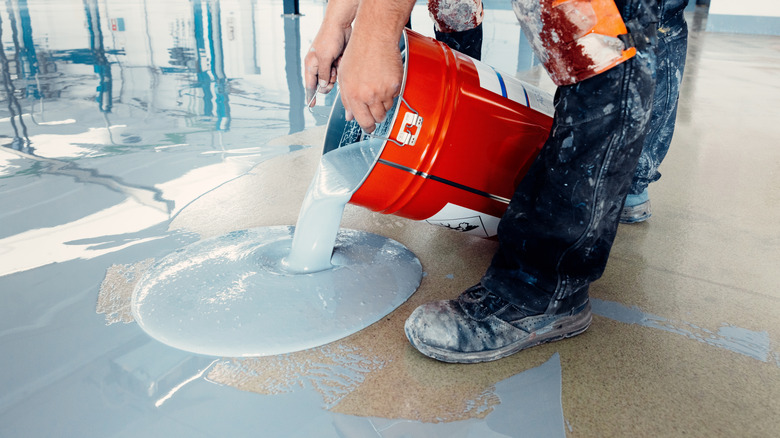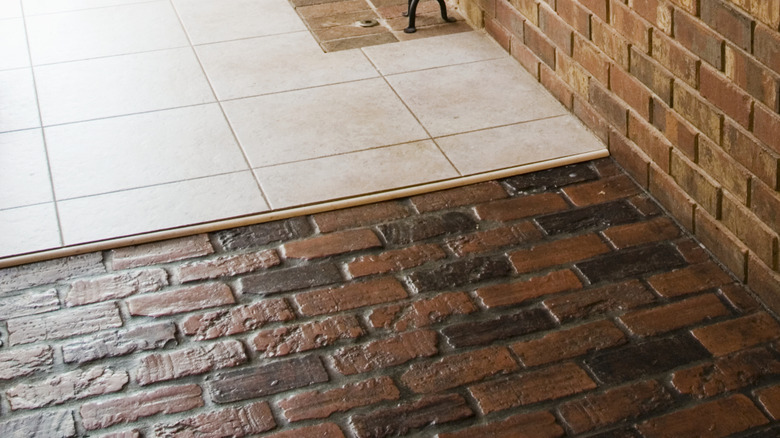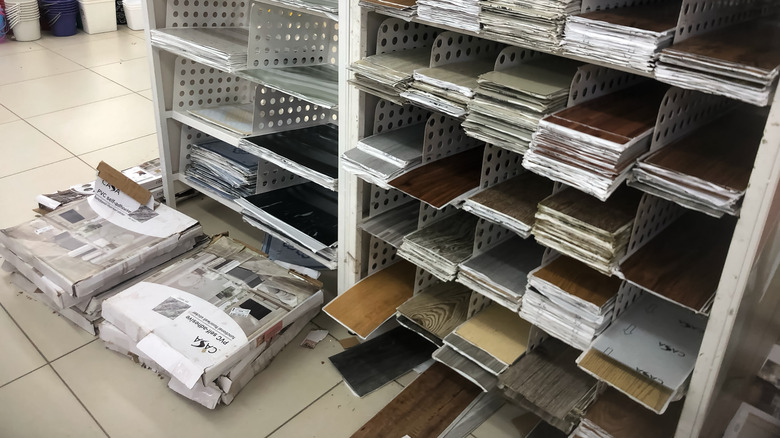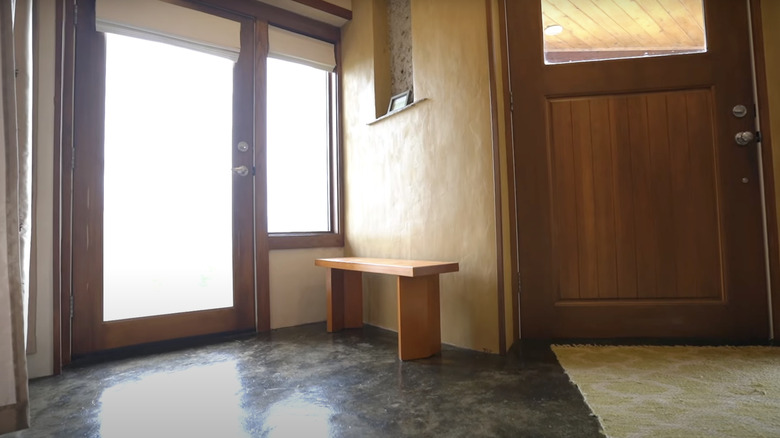If Concrete Floors Aren't Right For Your Home, Here Are Some Alternatives To Consider
We may receive a commission on purchases made from links.
If you're renovating, the floor choices can seem endless. Pricey hardwood. Durable ceramic tiles. Traditional terrazzo. Affordable vinyl plank. Which you choose can make or break your entire interior design concept. Concrete flooring is often recommended to homeowners by interior designers and home construction specialists alike for its long life, naturally insulating properties, easy recyclability, and, of course, good looks. But, like any single flooring type, it's not always the right choice for every home — or your home, more specifically.
How to know if concrete flooring is right for your space can be challenging for the average homeowner undergoing a new build or renovation. This is especially true if you're basing your choice on what's trending and not considering the downsides of this flooring type. Concrete flooring is generally associated with contemporary design, so may look out of place in historic homes. It's hard, so anything glass or ceramic dropped on it is likely to break; it's also prone to cracking over time. There's even evidence to suggest that standing on concrete floors for prolonged periods, such as when you're working in the kitchen, may be harmful to your health.
Thankfully, there are other choices that, while not exactly the same as, mimic its vibe while offering some substitute benefits. Top among them is epoxy, brick, concrete-look plastic products, and mud, though this is admittedly not an exhaustive list. Take time to explore these flooring alternatives before barrelling ahead with concrete flooring; you can make certain that what is arguably the most important interior design materials decision you'll make for your home is the best fit for your budget, needs, and aesthetic preferences.
Epoxy resin flooring is a cheaper look-alike to concrete flooring
Epoxy resin flooring, a mainstay of warehouses and garages, is increasingly being used in homes. It looks similar to concrete, especially if you choose concrete finish or concrete look epoxy resin flooring with two colored pigments swirled together. This floor material is softer and warmer underfoot than concrete and works especially well in wet areas. You can even add aggregates for enhanced functionality — make it, for example, anti-slip. There are, of course, drawbacks to consider. Some of the solvents used to cure epoxy resin floors can cause adverse health effects (prior to curing), from headaches and rashes to respiratory irritation and asthma. Epoxy resin contains BPA, a human health harming compound on the LBC Red List. Its waterproofing qualities mean it doesn't breathe, and this can trap dampness in old homes.
The best way to DIY epoxy garage floors to transform your space can be applied to the floors of your home, too. The essential steps include cleaning your existing subfloor and filling any cracks, mixing, pouring, and bruising the resin, and sealing the room until the floor cures (about 24 hours). DIY kits make light work of this job, like the Rockhard Color Epoxy 3 Gal. Kit in Dark Gray for almost $200. If you're not certain of your DIY skills or don't have access to the necessary tools and supplies, hire a professional to lay your epoxy resin floors for you. Prices for expert installation averages $3 to $12 a square foot. Note that there are other resins used for flooring, namely polyurethane and methyl methacrylate (MMA), but epoxy is the most common.
Replace concrete floors with the rustic charm of brick
In our list of the most stunning floor design choices we've seen on Fixer Upper, brick is applied in a herringbone pattern on top of a painted concrete floor. It's a great alternative flooring solution for anyone renovating a heritage home, embodying a Scandi or mid-century modern interior design vibe, or flooring more practical parts of the house like mudrooms, bathrooms, studios, and kitchens. Brick floors, like their conglomerate cousin, concrete, are enduringly hard, making them near-impervious to chips while being easy to sweep and mop clean. Unique advantages include flexibility with layout patterns and an undeniably rustic charm. They do, however, need sealing to ensure those red wine stains don't sink in for good.
A simple Titan Florida 7.75 x 3.75 Inch Solid Red Clay Brick costs a bit over $1 each at Lowe's, or try brick veneers, also called thin brick, which offer the look of a full sized brick without the hefty weight. Forty pieces of Jusmioke 2.4 x 7.9 Inch Red Thin Brick Veneers cost almost $70. Really channel those rustic vibes with reclaimed brick from demolished properties all over the U.S. Reclaimed Bricks' old Cleveland, Chicago, St. Louis, and Detroit brick samples cost $15 each, so you can trial the idea in your space first. To install brick floors, you need to lay mortar between the joins. A 10-pound bag of QUIKRETE Construction Grade Mortar Mix costs just about $20. Use a free online calculator — from Inch Calculator, for example — to work out how much brick and mortar you'll need for your floors.
Concrete-look finish vinyl, PVC, and linoleum tiles or planks
Concrete-look or concrete-effect laminate flooring made from vinyl, PVC, or linoleum is warm (physically), muffles sound, and resists moisture. Made from various plastics, it's surprisingly sustainable. In fact, in 2019, vinyl tile and linoleum was ranked above concrete for sustainability by the Building for Energy and Environmental Sustainability program of the National Institute of Standards and Technology and the Environmental Protection Agency (via Dovetail Partners). The downsides to these industrial-style tiles and planks? Gray hues — which most, if not all, of these imitation concrete boast — are among the flooring choices that may make it harder to sell your home. Off-gassing, where chemicals like formaldehyde leach from your flooring into the air, is a concern with some of these products. Look for low VOC products to reduce potential harm.
A 24-pack of VEELIKE 12 x 12 Inch Peel and Stick Grey Concrete Vinyl Floor Tile costs almost $60. A 4-pack of 12 x 12 inch Livelynine Industrial Concrete Peel and Stick Floor Tile goes for close to $12. Installation of these peel and stick options is as easy as the moniker implies. Measure your room, cut the tiles to size where needed, fit using spacers, and then stick them to the floor and roll to remove creases and secure the bond. Laminate planks require more tools — a hammer, a tape measure, a carpenter's pencil, and a plank cutting tool — and basic construction knowledge, so DIYing them is a little trickier, but still totally do-able. You could also recruit the services of a professional if you don't want to rent or buy the tools.
Mud flooring is a left-of-field option for those tired of concrete
In some parts of Africa, floors are constructed from a mixture of cow dung, straw, and dirt, a tradition stretching back likely thousands of years. Early North American settlers spread surface-improving sand and nut shells on their dirt floors. So, what is mud flooring and how is it being used in U.S. homes today? The material is quickly emerging as a sought-after contemporary flooring option. with home renovation TikTokers, interior designers, and off-grid enthusiasts alike proclaiming their love for the stuff. You'll sometimes see the practice referred to as dirt, earthen, earth plaster, adobe, or rammed earth flooring. Fair warning: While mud floors are undeniably beautiful, breathable, sustainable, and comfortable, they're also more prone to damage than pretty much any other flooring type and require continual maintenance.
You can make the mud mixture yourself using various recipes — typically, it's some mix of sand, clay, straw, manure and sometimes also lime. Pour this mud mixture onto your floors and trowel it flat in a circular motion. Once dry, brush the floor with a hard bristled broom to seal any cracks. Seal it using a natural oil like linseed oil. Adobe floors are made of sun-dried clay blocks. Texas Cob Co. sells 10 x 14 x 5 inch adobe bricks for $8 each. There are also a few ready-made options on the market, like Bostik's Mud-In-A-Bag Pre-Blended Floor Mud for under $12 from The Tile Store USA. Always follow the manufacturer's instructions when applying these mass-made products.
